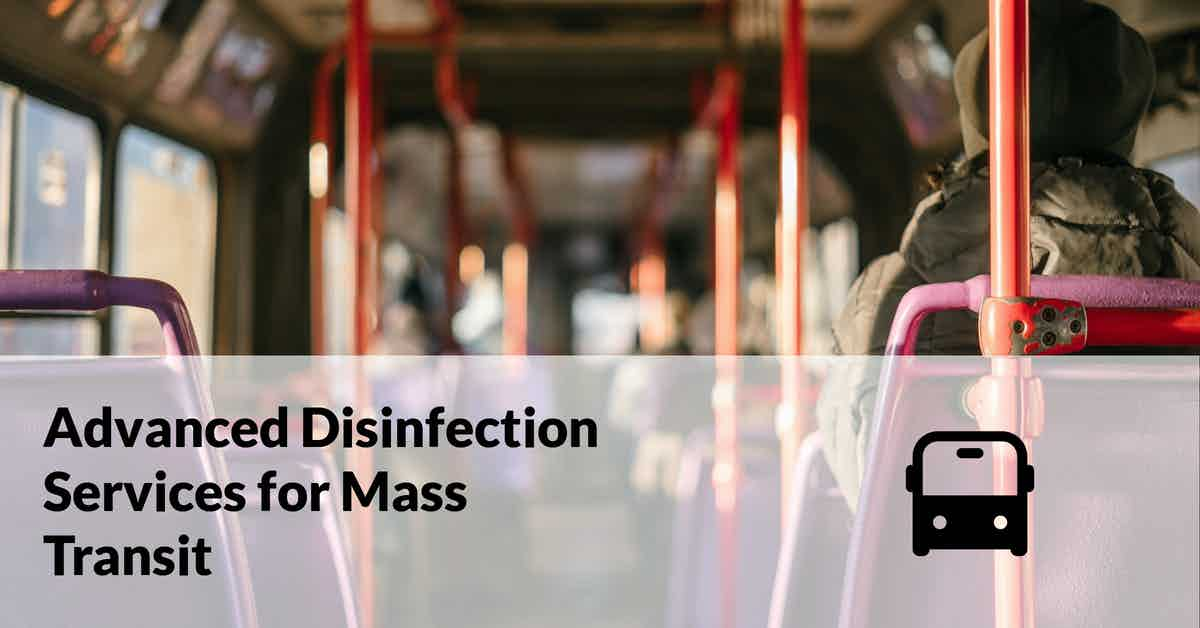Mass transit systems have remained in service for the duration of the COVID-19 pandemic, but have suffered huge financial losses due to poor public perception of cleanliness and safety, and massively reduced capacity leading many travelers to switch to other forms of transportation, representing potentially greater risks.

Ensuring the Safety of Mass Transit During COVID-19
Mass public transportation, specifically bus lines, has taken a huge hit during the pandemic lockdown procedures.
Social distancing orders resulting in reduced capacity allowances have created extended wait times for passengers who have opted for alternatives they felt were safer and more accessible, leading to massive financial deficits for the public transportation entities.
According to Time Magazine;
Buses [...] that once carried anywhere from about 50 to 100 passengers have been limited to between 12 and 18 to prevent overcrowding in response to coronavirus.
Public transit use has plummeted nationwide as people work from home or avoid buses and subways for fear of contracting COVID-19, resulting in less revenue from fares.
And as the economy cratered, so too have the tax revenues upon many which many transit systems rely.
Philadelphia’s SEPTA is looking at upwards of $300 million in lost revenue through mid-2021.
Maryland’s Transportation Trust Fund is contending with a $550 million shortfall in the fiscal year ending June 30, with similar losses expected next year.
Los Angeles Metro is preparing for $1.8 billion in pandemic-related revenue losses.
Chicago’s CTA is facing a half-billion dollar falloff in 2020.
COVID-19 Has Been 'Apocalyptic' for Public Transit. Will Congress Offer More Help?
Additional factors cited in passenger transitions to other forms of transit, such as ride-sharing, taxis, and paratransit, include:
- Failure to manage and maintain social distancing and reduced passenger number requirements.
- Surface cleanliness and hygiene.
- Proximity to potentially contagious passengers, and;
- A failure to enforce mask requirements.
What many individuals may not be aware of is that all forms of public transportation are subject to the same kinds of risks due to SARS-CoV-2's survivability outside of the human body and the methods by which it most commonly spreads.
Understanding SARS-CoV-2 Transmission Methods and Risks on Public Transit Systems
SARS-CoV-2 is most commonly spread via close proximity to an infected person, so ride-sharing in tight corridors over a protracted period should be considered high risk, especially if you're sharing the vehicle with someone outside your home.
According to The Federal Emergency Management Agency (FEMA);
Individuals should only use public transit for essential travel.
This includes travel for essential personnel including, but not limited to, first responders, hospital staff, critical government employees, grocery, and pharmacy workers and others who must work during the public health emergency.
Individuals should avoid using public transportation if they are feeling ill.
Instead, they should call their doctor before leaving home to determine if using public transportation is wise.
COVID-19 Best Practice Information: Public Transportation Distancing
The second most common method is surface to human transmission--touching a contaminated surface and then your face, eyes, nose, or mouth.
According to the U.S. Centers for Disease Control and Preventions (CDC) recommendations for protecting themselves on public transit, individuals should;
Avoid touching surfaces.
As much as possible, limit touching frequently touched surfaces such as kiosks, digital interfaces such as touchscreens and fingerprint scanners, ticket machines, turnstiles, handrails, restroom surfaces, elevator buttons, and benches as much as possible.
If you must touch these surfaces, as soon as you can, wash your hands for 20 seconds with soap and water or rub your hands with sanitizer containing 60% alcohol.
Use touchless payment and no-touch trash cans and doors when available. Exchange cash or credit cards by placing them in a receipt tray or on the counter rather than by hand, if possible.
Mitigating Public Transit Risks
Mitigating risks associated with public transit systems of any kind is not a simple matter, especially during the cold winter months.
Current recommendations include:
- Wearing masks.
- Social distancing.
- Reducing travel times to limit passenger exposure.
- Loading and exiting from the rear of the bus to protect the driver.
- Opening windows to increase airflow or turn off the AC/heater when in transit to reduce unfiltered air circulation.
- Install commercial-grade air cleaners, and;
- Maintaining high standards of surface cleanliness and hygiene.
Keeping Public Transportation Clean and Safe With Enhanced Disinfection Services
Increasing cleaning and disinfection frequencies is a proven method for addressing pathogen outbreaks, and SARS is no exception.
Occupied ride-share vehicles, taxis, paratransit vans, busses, and trains should all be:
- Cleaned with a commercial-grade soap-based detergent at the end of every shift, and;
- Subject to germ hot spot disinfection wipe downs multiple times per day.
Major areas of concern include:
- Seats, grab handles, and armrests.
- Partition glass.
- Door handles.
- Safety belt buckles and the surrounding fabric.
- Dashboards, rearseat controls, and credit card processing units in taxies, and;
- Doors and windows.
This may appear and likely is a monumental task, potentially requiring a substantial increase in labor-time to accomplish.
Fortunately, advanced technologies, specifically electrostatic disinfection, can significantly reduce the amount of time and money necessary to fully disinfect a vehicle, ensuring not only maximum public safety but maximum availability of desperately needed essential transportation systems.
References & Resources
- Electrostatic Sprayers Disinfect Vehicles, Too
- What's the risk of catching COVID-19 on public transportation?
- School bus safety during the COVID-19 pandemic: 8 recommendations
Takeaway
The availability of mass transit systems, especially busses, trains, and similar forms of transportation, is vital for public health and welfare--providing essential services to urban residents across the country with few travel alternatives.
While the management of recommended best practices in each city is likely a subject for debate, the safety of the systems can be ensured by adhering to well-documented best practices, which include increased enhanced cleaning and disinfection services, which have demonstrated their effectiveness against the outbreak of airborne pathogens in the past, even among vulnerable demographics, such as young children.
Outsourcing advanced cleaning services, especially electrostatic disinfection, is a proven method for cost-effectively onboarding proven pathogen elimination methods.
Contact us today and discover why Vanguard Cleaning Systems® is the Standard of Clean® for businesses throughout Northwest Arkansas, Missouri, and Oklahoma.
In Oklahoma, dial 918-960-4450
In Arkansas, dial 479-717-2410
In Missouri, dial 417-812-9777

